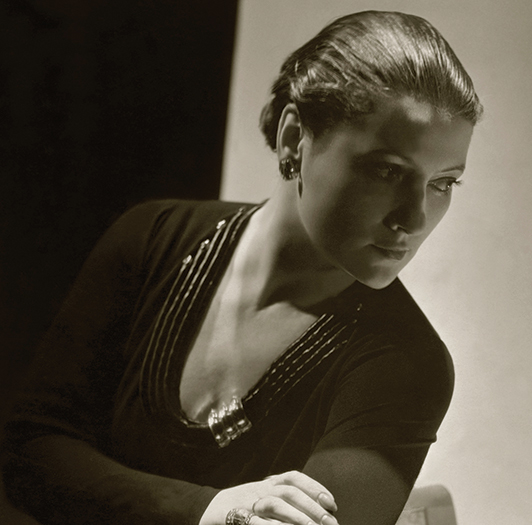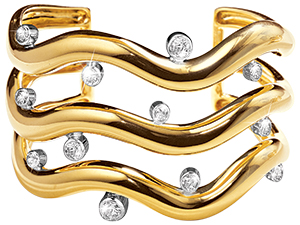|
Legacy
My Style Is My Signature
The distinctive style of French jewelry designer Suzanne Belperron is being introduced to a wider audience.
By Phyllis Schiller
 |
| Suzanne Belperron photo by Horst P. Horst, 1934; courtesy Verdura. |

|
| Gold, platinum and diamond Triple Wave Cuff, Belperron.
|
Although the view out of the window is Central Park, the Fifth Avenue aerie that houses the Belperron Collection has the look and feel of 1930s Paris. A deliberate choice, points out Nico Landrigan, president of the company that opened its doors just about a year ago. But the planning and effort that has gone into this debut has been many years in the making.
The Parisian-style setting is fitting for the salon, which pays homage to the creativity of French jewelry designer Suzanne Belperron. Finding her spot in the male-dominated world of twentieth-century French haute joaillerie was a testament to her talent. But the power of her jewelry in the twenty-first century wasn’t reaching beyond a rarified sector of jewelry fans who could afford to buy her pieces when they came up at auction. At least until now.
The opportunity to acquire the Belperron name and archive of over 9,300 design drawings — “exquisitely rendered” by Belperron, says Nico — was a seemingly perfect fit for his father Ward Landrigan. He purchased them in 1998, several years after purchasing Verdura, another iconic designer with a celebrated clientele of the rich and royalty. “I think it’s a brilliant combination,” acknowledges Nico. “But my dad would laugh if you asked him at what point he decided to do it. Our lives don’t work that way. These two opportunities presented themselves and they were the two jewelry designers he really cared about. The archival work was there, the quality of everything from design to gemstone to clientele was there and so he felt he couldn’t say no to them.”
“I think Belperron was a brilliant designer who changed jewelry design in the twentieth century,” continues Nico. “Historically speaking, however, she doesn’t get nearly enough credit for that.” He hopes that if more women who love great jewelry discover her work, they will “retroactively give her the credit that’s she’s due. And if that means we grow our business a bit, then I’d be happy for that, too.”
Belperron, née Suzanne Vuillerme, was born in the town of Saint-Claude in eastern France on September 26, 1900. In 1901, the family moved to Bescançon, where she trained at the École des Beaux-Arts. Although she lacked the wealth or connections of many of her male counterparts, Belperron was able to parlay her talent into a thriving career. Arriving in Paris at the age of 19, she secured work at Maison Boivin. In 1932, she went to work for natural pearl and gem dealer Bernard Herz, where she further refined the bold, sensuous style that set her apart. To avoid having Herz, who was Jewish, lose his business to the Nazis, she registered it under her name. Although Herz died in Auschwitz, his son, Jean, a prisoner of war, returned to Paris in 1945. The firm, which thrived under the new name Herz-Belperron, closed in 1974. Belperron died March 28, 1983. The fact that her designs were mostly unsigned —“My style is my signature,” she famously declared — meant that many of her pieces were not immediately identified as her work.
Belperron, Nico says, was “one of the early pioneers of Art Deco.” A study for a school project was found that had been separated from the archives, he notes, “and you can see a direct line to precursors of Art Deco.” But when everyone else began doing it, “she moved on to this new aesthetic that she became known for, with sensuous lines and curves and tribal influences. But I think she always kept as a guideline, Art Deco’s strict rules of proportion and repetition. And that’s why she is so relevant today. There’s nothing extraneous. She didn’t muck things up with an extra twirl or tendril or motif. It was very clean and pure,” explains Nico. “If Steve Jobs ever took a minute off to study jewelry, I’m confident he would have found an affinity with Belperron’s jewelry. It has that same element of simplicity and modernity as his product designs.”
The premier collection, which currently numbers 120 pieces, is a mix of both vintage and newly manufactured jewelry, the latter hallmarked “Belperron.” The criteria for Nico in choosing the first pieces from the archives came down to which drawings spoke to him. “Some pieces just catch hold of your imagination and won’t let go. Once you see what she meant in her design by a shadow here and a highlight there and start to see it in your mind’s eye, you can’t imagine not making it.”
How many of each of the “new” designs will be produced depends upon the workshops in Paris manufacturing them, one of which has a direct family line to the original craftsmen who worked for Belperron. No matter what, the number will be kept small. “I’d like to always maintain our core principles that jewelry is produced in the original way, handmade with as much care to function and structure and beauty in the back as the front. There are pieces that I would only ever make one of and then there are pieces like the ‘roof’ gold earrings that we’ve already made five pairs of. Which is not a big number, but it says it’s a hit.”
To coincide with Belperron’s launch, there is a sumptuously illustrated book, Jewelry by Suzanne Belperron by Patricia Corbett, Ward Landrigan and Nico Landrigan. It is a biography of both Belperron’s life and her life’s work in jewelry. “We spent a lot of sleepless nights poring over it to make sure we got it right. There’s so much misinformation around.”
In terms of future plans, there are still, Nico says, a wealth of designs to choose from, “including amazing pieces with shades of every sapphire type you can imagine from Ceylon to Burma to Kashmir that would be fun to make. But you need a little bit of size to pull that off.”
Belperron, whose designs often created challenges for her craftsmen, is known to have overruled their objections with the phrase, “Messieurs, débrouillez-vous!” translated as “Gentlemen, manage it!” It seems, in a case of art imitating life, Nico and company are doing just that.Article from the Rapaport Magazine - October 2016. To subscribe click here.
|
|